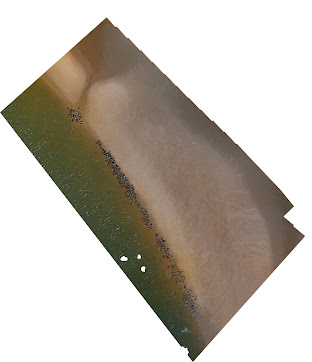Hey there! I’m a new PhD student at Scotland’s Rural College (SRUC) in Aberdeen, and I’m super excited to share my research journey with you. This year, I will be spending a lot of time at Newburgh Seal Beach, observing the seal colony that calls this place home. It’s been an exciting start, and I can’t wait to dive into the details with you.
So, what’s so special about these seals? Well, they’re grey
seals, and they hang out on the beach all year round. But here’s the
interesting part: their numbers change with the seasons. My mission this year
is to gather all kinds of cool ecological data about them. I’m looking into how
different age groups and gender of seals use the beach and where they prefer to
rest. To do this, I’m using drones to snap aerial photos of the colony. From
these bird’s-eye views, we can estimate the seals’ age by their size, determine
their sex by the colour of their fur, and see exactly where they like to chill.
You might be thinking, “Okay, cool, but why does this
matter?” Well, understanding these patterns is like cracking the code of seal
behaviour. Younger seals, for example, are still figuring out the best fishing
spots and techniques. That means they need to rest more often than their older,
more experienced counterparts. Plus, where they choose to hang out on the beach
is influenced by the tides. Seals that stay further up the beach have more time
to rest between tides compared to those closer to the water.
Making Waves in the Real World
Now, let’s talk about why this matters in the grand scheme
of things. Knowing more about seal behaviour helps us understand our impact on
them. Here’s a story for you: Despite protections put in place in 2017, people
still wander onto the beach to get a closer look at the seals. During one of my
recent surveys, I captured the number of seals on the beach drop after some
visitors got too close. After looking at the data I found most of the seals
that took off were the younger ones, and the ones that stayed moved further
down the beach.
This shows just how much we can affect these animals, even
without meaning to. By being mindful of our actions and keeping a respectful
distance, we can help protect these amazing creatures and their beachside home.
So, there you have it—a sneak peek into my world as a PhD
student studying seals. Stay tuned for more updates from the seal colony at
Newburgh Seal Beach!
The aerial images were taken as part of a PhD study by the Aberdeen Marine Mammal Project based at Scotland’s Rural College (SRUC) gathering data on the environmental factors influencing seal haul-out behaviour, you can learn more about the research here: (https://www.aberdeenmarinemammals.org/seals-ythan-estuary). Credit Claire Stainfield, taken under licensed research drone usage as permitted by NatureScot.





Comments
Post a Comment